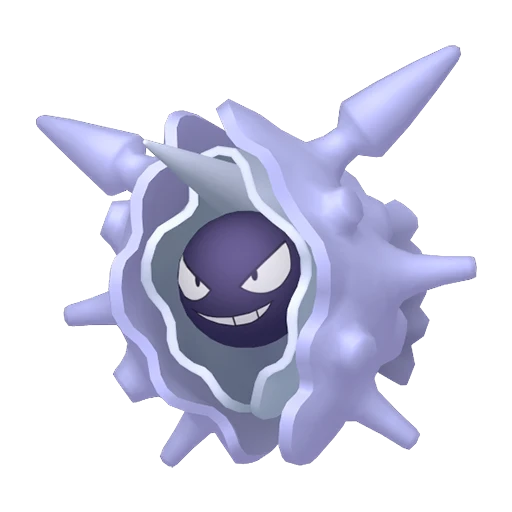
Cloyster
(1) : generation-i
Cloyster (#91) is a Water/Ice-type Pokémon known for its rock-solid, spiked shell that can withstand even explosive blasts. With its razor-sharp shell and powerful clamp, Cloyster is a force to be reckoned with in battle. Fun fact: when it clamps down, nothing can pry its shell open—not even a bomb!
Votes
2
Favorites
0
Caught
0
2-0
100.00%
Votes for Cloyster
Bio
Cloyster: The Complete Biography of the Bivalve Pokémon (#91)
Cloyster is a remarkable Pokémon that has captured the fascination of trainers and collectors since its debut in Generation I. Known as the Bivalve Pokémon, Cloyster is instantly recognizable for its spiky, armored shell and menacing gaze. It stands as Pokédex number #91 and is a dual Water and Ice-type, giving it a unique blend of strengths and strategic possibilities in battle. This comprehensive biography explores Cloyster’s lore, stats, evolution chain, and its presence in the Pokémon trading card game.
Cloyster Evolution: From Shellder to Powerhouse
Cloyster’s journey begins with Shellder, its pre-evolution form. Shellder is a simple Water-type Pokémon found in various bodies of water throughout the Pokémon world. The transformation from Shellder to Cloyster occurs when a Shellder is exposed to a Water Stone. This evolution is not just cosmetic—Shellder’s soft, vulnerable body is encased in an almost impenetrable shell, transforming it into the formidable Cloyster.
Evolution Chain:
- Shellder (Water-type) → Water Stone → Cloyster (Water/Ice-type)
This evolutionary leap brings significant power and versatility, making Cloyster a popular choice for trainers seeking a robust Water/Ice-type Pokémon.
Cloyster Stats: Defense and Offensive Potential
Cloyster’s stats are a major reason for its enduring popularity. Here's a breakdown of its key attributes:
- HP: 50
- Attack: 95
- Defense: 180
- Special Attack: 85
- Special Defense: 45
- Speed: 70
Cloyster is renowned for its exceptional Defense stat (180), among the highest in the Pokémon universe. This makes it incredibly resilient against physical attacks. Its respectable Attack (95) and Special Attack (85) allow Cloyster to deal significant damage, especially when equipped with powerful moves like Icicle Spear, Hydro Pump, and Shell Smash—the latter being a game-changer that boosts Cloyster’s offensive stats at the cost of some defense.
The combination of Water and Ice types gives Cloyster access to a versatile movepool, making it effective against a range of opponents, including Ground, Flying, Dragon, and Grass-types.
Cloyster Lore: The Bivalve Pokémon’s Mystique
Cloyster’s lore is as intriguing as its battle capabilities. According to various Pokédex entries, Cloyster closes its shell tightly to protect itself from foes. Its shell is so hard that even explosives cannot penetrate it. When threatened, Cloyster can shoot sharp spikes from its shell with enough force to pierce through almost anything.
Another fascinating element of Cloyster’s lore is its habitat. While often found in cold, deep seas, Cloyster is sometimes discovered washed up on stormy beaches or hiding in underwater caves. Its mysterious nature and elusive behavior have made it a subject of countless myths in the Pokémon world. Some stories even suggest that pearls formed by Cloyster are the most beautiful and valuable in existence.
Cloyster in the Pokémon Trading Card Game
Cloyster has made several memorable appearances in the Pokémon trading card game (TCG). Its cards often emphasize its defensive prowess and unique abilities, such as Shell Armor and Clamp Crush. Collectors and competitive players alike seek out Cloyster trading cards for both their aesthetic appeal and strategic value.
Notable Cloyster trading cards include:
- Base Set Cloyster: One of the earliest cards, featuring classic artwork and solid defensive moves.
- Sun & Moon Cloyster: Showcases updated abilities and synergy with Water and Ice-type decks.
- Sword & Shield Cloyster: Introduces new moves and abilities in line with the modern metagame.
These trading cards capture the essence of Cloyster, making it a fan-favorite among TCG enthusiasts.
Conclusion: Cloyster’s Lasting Impact
With its distinctive design, impressive stats, and rich lore, Cloyster remains a staple in the Pokémon franchise. Whether you’re exploring its evolution chain from Shellder, analyzing its defensive and offensive stats, delving into its mysterious lore, or collecting Cloyster trading cards, there’s always something new to discover about this iconic Water/Ice-type Pokémon. For trainers and collectors alike, Cloyster is a testament to the depth and wonder of the Pokémon universe.







